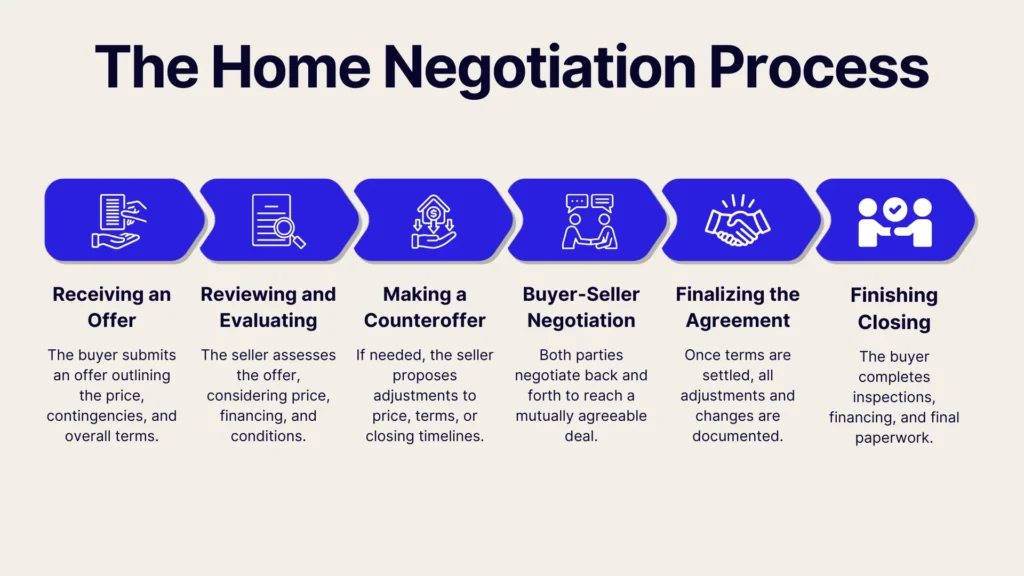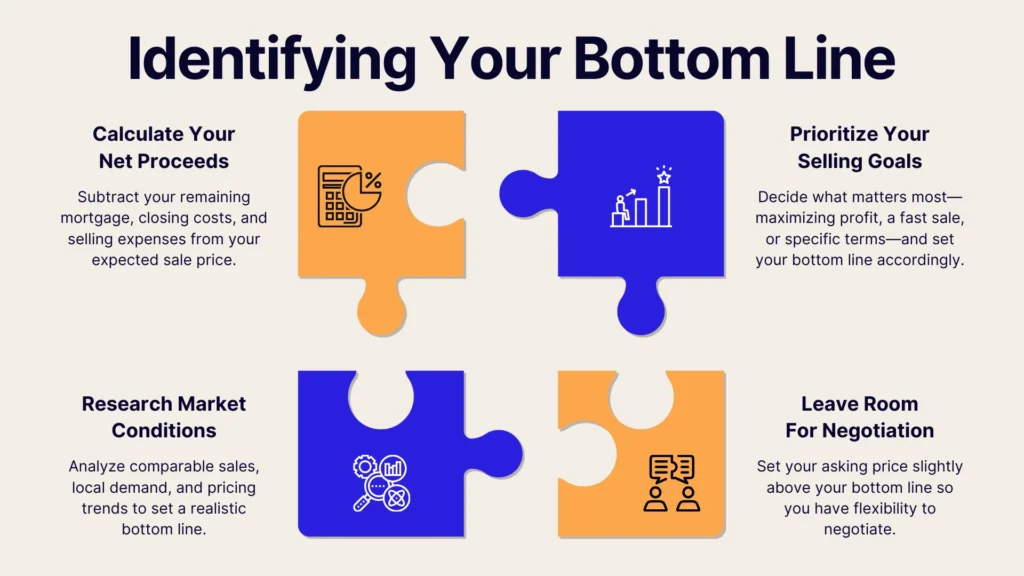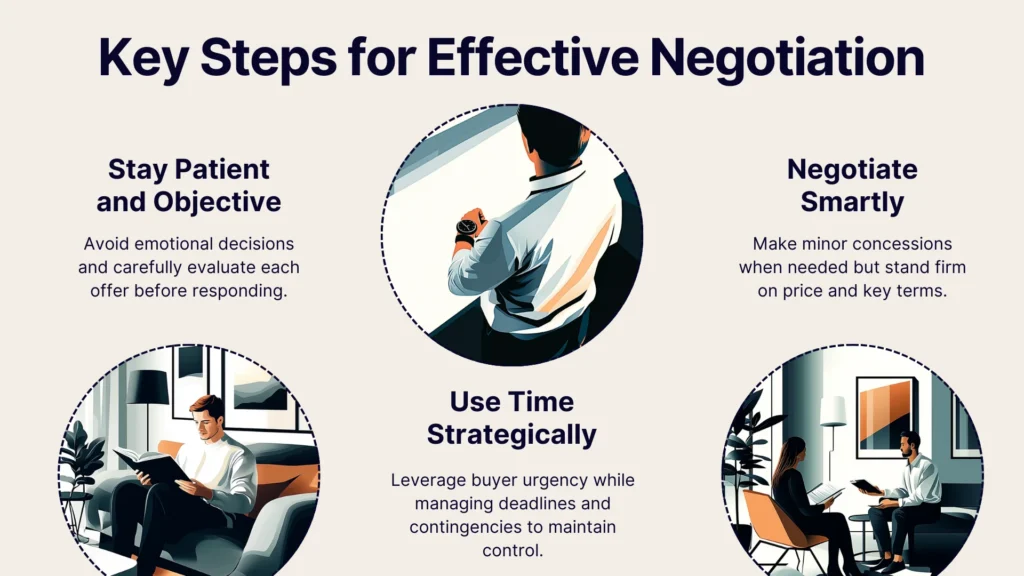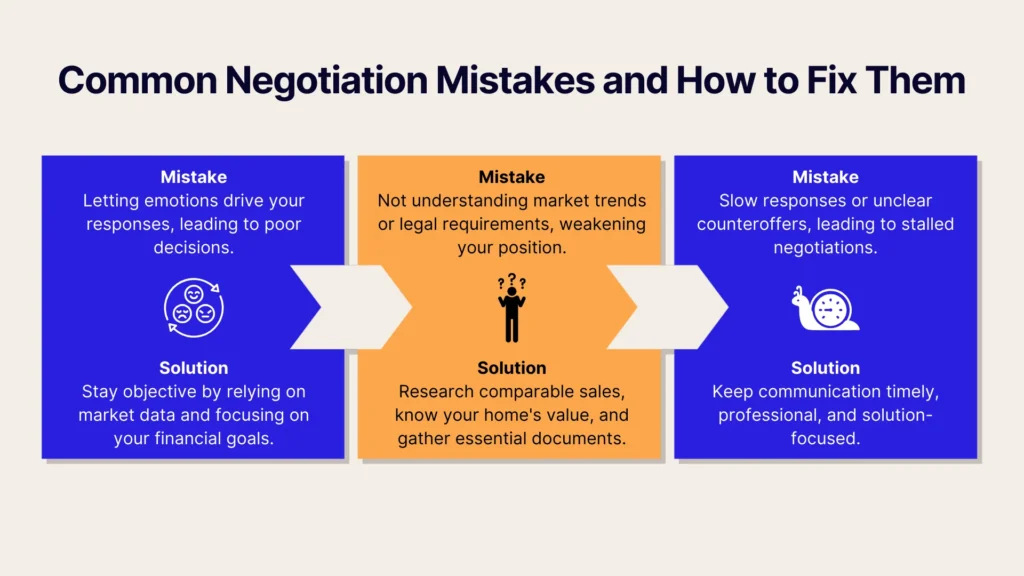Selling your home as a For Sale By Owner (FSBO) can be an empowering and cost-saving choice, but it also comes with challenges, especially when negotiating offers. Without the expertise of a real estate agent, you’ll need to take on the role of negotiator, ensuring you secure the best possible deal while maintaining professionalism and composure.
Whether you're dealing with seasoned buyers or their agents, understanding effective negotiation strategies is crucial to protecting your interests and maximizing your profit. This guide will provide actionable tips explicitly tailored for FSBO sellers, helping you navigate the negotiation process confidently and successfully.
Understanding Negotiation in Home Selling
Negotiation in home selling is a critical process where buyers and sellers work to reach mutually agreeable terms for selling a property. Here’s an overview of how it typically works:
- Receiving Offers: The negotiation begins when a seller receives one or more offers from potential buyers. Each offer includes key components such as the price, contingencies, closing date, and financing terms.
- Evaluating Offers: Sellers assess these offers based on their priorities, such as achieving the highest price, securing favorable terms, or meeting specific timelines. Factors like market conditions (e.g., buyer’s or seller’s market) can influence the possibility for negotiation.
- Counteroffers: If the seller’s expectations are unmet by the initial offer, they can issue a counteroffer. This might include adjustments to the price, contingencies, or other terms like closing costs or included appliances.
- Concessions and Adjustments: Both parties may negotiate concessions, such as repairs following a home inspection or assistance with closing costs. These adjustments help bridge gaps between the buyer’s and seller’s expectations.
- Final Agreement: The negotiation concludes when both parties agree on all terms, including price and contingencies. If no agreement is reached, either party may withdraw from the deal.

Effective negotiation requires understanding market dynamics, clear communication, and flexibility to find solutions that satisfy both parties' needs.
Preparing for Negotiations as a Seller
Selling your home without an agent means you'll be handling negotiations directly with buyers and their representatives. Preparation ensures you control the process, maximize your sale price, and avoid costly mistakes. Let’s take a look at some tips that can help you prepare for your home sale:
Understanding Your Home’s Market Value
One of the most critical steps in preparing for negotiations as an FSBO seller is clearly understanding your home’s value. Buyers and their agents will come armed with market data, and you need to be just as informed to justify your asking price and negotiate effectively. Here’s how you can determine your home’s fair market value:
- Research Comparable Sales: To reflect current market conditions, look at homes sold within the last 3 to 6 months. Focus on properties with similar square footage, lot size, number of bedrooms and bathrooms, and overall condition. Consider features that could add or subtract value, such as renovations, a finished basement, or a desirable view.
- Analyze Pricing Trends in Your Market: Beyond individual comps, it’s important to understand broader pricing trends in your area. This will help you gauge whether home values are rising, stabilizing, or declining. Track the average days on market (DOM) for similar homes—longer times may indicate a buyer’s market, while shorter times suggest strong demand.
- Get a Professional Appraisal: If you want an objective, expert opinion on your home’s value, hiring a professional appraiser can give you more accurate numbers.
Identifying Your Bottom Line
Before entering negotiations, establish the lowest price and terms you're willing to accept. Doing so will prevent emotional decision-making and ensure you stay firm on what matters most.
To determine your bottom line price:
- Start by calculating your net proceeds after deducting mortgage payoffs, closing costs, and any outstanding expenses.
- Factor in market conditions and buyer demand—if homes sell quickly, you may have room to negotiate a higher price.
- Set a firm minimum price but remain flexible for strong offers with favorable terms (e.g., cash buyers or quick closings).
Then, determine your ideal terms, such as the closing timeline, buyer financing, inspection and repair requests, and inclusions/exclusions.

Gathering Relevant Property Documents
When negotiating offers on your home, having relevant property documents on hand can quicken the process and keep you on top of every nuance. Documents to prioritize include:
- Original Sales Contract: Provides historical context.
- Property Survey: Defines property boundaries.
- Homeowners Association Documents: Includes rules and fees.
- Property Title: Proves ownership.
- Appliance Manuals and Warranties: Useful for buyers.
- Preliminary Title Report: Ensures clear ownership.
- Property Tax Bills: Helps buyers understand costs.
- Loan Documents: Necessary for financial clarity.
- Mandatory Disclosures: Required by law to reveal known issues.
- Home Inspection Report: Highlights property condition.
Initiating the Negotiation Process
Once you've set your pricing strategy, gathered key documents, and prepared for potential counteroffers, it's time to engage with buyers. Whether you receive an initial offer or need to encourage one, how you handle the first steps can set the tone for the entire negotiation.
Responding To The First Offer
When you receive the first offer, take the time to review it carefully rather than reacting emotionally. Consider the price and terms, such as contingencies, closing timeline, and financing details. If the offer is firm and meets your minimum acceptable price and terms, you may accept.
However, if it falls short, you can counteroffer with adjustments that better align with your goals—whether that means negotiating a higher price, modifying contingencies, or adjusting the closing date. Even a low initial offer can start a productive negotiation, so respond professionally and focus on finding common ground while protecting your bottom line.
Crafting Your Counteroffer
Start by identifying key aspects of the offer you want to adjust—price, contingencies, closing timeline, or included items. Clearly outline your counteroffer in writing, maintaining a firm but cooperative tone. Justify your terms with market data or home features to strengthen your position. Adjust only a few key points if possible to keep negotiations moving smoothly. Always set an expiration deadline to encourage a timely response and maintain momentum in the negotiation process.
Key Negotiation Tactics for Sellers
Once negotiations begin, how you handle the process can significantly impact the final outcome. A well-thought-out approach helps you stay in control, avoid costly mistakes, and secure the best possible terms. Here are some things to remember:
- Be Patient: Avoid rushing into decisions or reacting emotionally; carefully assess each offer.
- Use Time as Leverage: Buyers may be eager to close quickly, so strategic delays can work in your favor. Stay mindful of deadlines but don’t let pressure force a bad deal.
- Control Deadlines & Contingencies: Set reasonable but firm time frames for inspections, financing, and closing to keep the process on track without unnecessary delays.
- Make Strategic Concessions: To keep the deal favorable, be flexible on minor terms (like closing dates or small repairs) while holding firm on price and significant conditions.

Enhancing Negotiation Through Presentation
First impressions matter; how your home is presented can directly influence buyer interest and offer strength.
A well-staged home creates an inviting atmosphere that helps buyers envision living there, increasing its perceived value.
High-quality, professional photography further enhances your listing, attracting more serious buyers and setting the stage for more substantial negotiations. This section will explore how strategic presentation can work in your favor during the selling process.
Staging your home effectively is one of the best ways to create a strong first impression and maximize its perceived value. A clean, well-organized space allows buyers to envision themselves living there, making them more emotionally invested in the property.
Focus on decluttering, depersonalizing, and highlighting key features such as natural light and updated finishes. Small touches like fresh paint, modern decor, and neutral color schemes can significantly impact buyer perception.
Professional photography is equally important in attracting serious buyers and making your listing stand out. High-quality images showcase your home’s best features, increasing online engagement and drawing more interest from potential buyers.
Leveraging Home Inspections
Home inspections play a crucial role in negotiations, and as a seller, you can use them strategically to maintain control and minimize surprises.
- Pre-Listing Inspections: Getting a home inspection before listing can help you identify potential issues early, allowing you to make repairs in advance or adjust your pricing accordingly. This proactive approach can prevent last-minute surprises that delay closing or give buyers leverage to negotiate a lower price.
- Negotiating After the Buyer’s Inspection: Once the buyer conducts their inspection, they may request repairs, closing credits, or a price reduction based on the findings. Review their requests carefully and determine which are reasonable and which you’re willing to negotiate. Offering a repair credit can be easier than fixing minor issues yourself. If the buyer’s demands are excessive, you can push back with comparable sales data or refer to your pre-listing inspection to justify your position.
Understanding Buyer Psychology
Understanding how buyers think can give you an edge in negotiations, helping you craft a strategy that moves the deal forward while protecting your interests. Here’s how buyer psychology can tell you about a potential homeowner’s readiness.
Recognizing Serious Buyers
Not all inquiries lead to genuine offers. Serious buyers are typically pre-approved for financing, ask detailed questions, and show a genuine interest in your home’s condition and features. They often move quickly to schedule showings and submit offers. In contrast, "tire-kickers" may be just browsing or testing the market without a clear intention to buy.
Tailoring Your Approach To The Buyer
Different buyers respond to different negotiation styles. A first-time buyer may need more reassurance and flexibility on contingencies, while an investor may focus purely on numbers. If a buyer is emotionally attached to your home, emphasizing its unique features can justify a higher price. Understanding their priorities—price, closing timeline, or included items—allows you to adjust your approach and find a win-win deal.
Common Negotiation Mistakes
Negotiating a home sale requires strategy and composure. Avoiding common mistakes can help you secure better terms and keep the deal on track. Here are some negotiation red flags to keep in mind.

Emotional Decision-Making
Selling a home is personal, but letting emotions drive your decisions can lead to costly mistakes. Overpricing due to sentimental attachment or reacting defensively to low offers can push buyers away. Stay objective by focusing on market data and long-term financial goals rather than personal feelings.
Insufficient Preparation
Walking into negotiations without a strong understanding of market trends, comparable sales, and necessary paperwork puts you at a disadvantage. Buyers and their agents will come prepared—make sure you do too. Knowing your home’s value, potential deal-breakers, and legal requirements will help you negotiate confidently.
Ineffective Communication
Slow responses, unclear counteroffers, or an overly aggressive approach can frustrate buyers and stall negotiations. Keep communication professional, timely, and solution-focused. A well-crafted counteroffer and open dialogue can keep buyers engaged and increase your chances of closing a favorable deal.
Legal Considerations in Negotiation
Negotiating a home sale isn’t just about price and terms; it also involves legal responsibilities. Failing to meet these obligations can lead to disputes, delays, or legal consequences.
Disclosure Requirements
As a seller, you must legally disclose known issues with your property, such as structural problems, water damage, or past repairs. Failing to disclose significant defects could lead to legal action from the buyer after closing. Providing complete and honest disclosures protects you from liability, builds trust, and reduces the risk of last-minute deal breakdowns.
Legal Ramifications Of Negotiation Missteps
Misrepresenting facts about your home, making verbal agreements you don’t intend to honor, or failing to document negotiated changes properly can result in serious legal consequences. Ensure that all negotiated terms—such as repairs, closing costs, or included appliances—are clearly outlined in the contract. Consult a real estate attorney to avoid costly mistakes and protect your interests when in doubt.
Finalizing the Deal
Once negotiations are complete, the final step is ensuring all agreements are appropriately documented and the closing process moves forward smoothly. Attention to detail at this stage prevents misunderstandings and last-minute hurdles.
Review your sales agreement, which should clearly outline the agreed-upon price, contingencies (such as inspections and financing), closing timeline, and any negotiated terms, like repairs or included appliances. Both parties must review the contract carefully to ensure accuracy before signing.
Before finalizing, confirm that all parties fully understand the agreement. If any last-minute concerns arise, address them promptly and professionally. Work closely with the buyer, lender, and legal professionals to ensure timely paperwork.
Be prepared for final inspections, appraisals, and any required repairs. By staying organized and proactive, you can confidently navigate the final steps and successfully close the sale.
Conclusion
Successfully negotiating a home sale as an FSBO seller requires preparation, strategy, and confidence. You can secure the best possible deal by understanding your home’s value, setting clear price limits, leveraging inspections, and using clever negotiation tactics.
To simplify your FSBO journey, streamline negotiations, and easily manage offers, use PropBox – a powerful platform designed to help sellers take control of their home sale. Get started today and negotiate with confidence!
